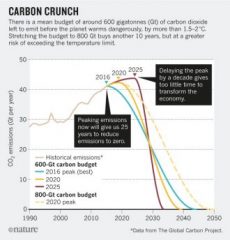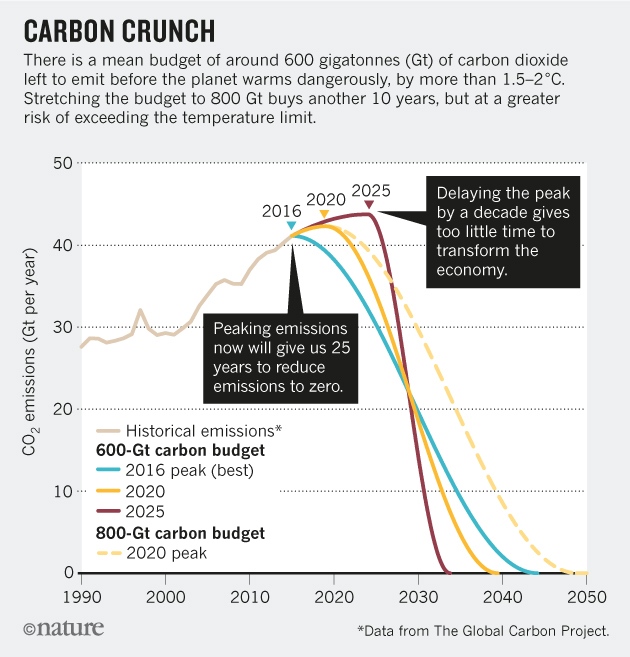Every single person in Trump’s cabinet denies the existence of climate change at a time when scientists are ringing the alarms louder and louder. The latest research shows the world literally has 3 years to make aggressive progress on bringing emissions down – if we don’t, we will cross irreversible tipping points and feedback loops.
First, The Good News
The good news is that, for the third consecutive year, the world’s carbon emissions are flat … even as the economy grew by 3%, according to the Global Carbon Project.
This is a sharp contrast from a decade ago, when emissions grew about 3% a year, notes Glen Peters, a scientist at Norway’s Center for International Climate and Environmental Research. Leveling off of emissions is directly attributable to less coal burning in the US and China.
But stabilizing emissions isn’t good enough – we’re still sending 41 gigatons of carbon into the atmosphere every year. Emissions MUST come down and fast.
“The good news is that it is still possible to meet the Paris temperature goals if emissions begin to fall by 2020,” say scientists in the prestigious journal, Nature. “Should emissions continue to rise beyond 2020, or even remain level, the temperature goals set in Paris become almost unattainable.”
- Under the Paris Accord, nations agreed to stay below 2°C and to shoot for 1.5°C, which would be far safer. As of 2016, we are at 1.2°C, according to NOAA and the World Meteorological Organization (WMO).
- In 2016 – the hottest year yet – atmospheric carbon levels crossed the threshold over 400ppm of carbon – permanently. We are now at 410ppm year-round.
- Arctic ice is at all-time lows. Most researchers expect an ice-free Arctic between 2030-2050 – the first time in more than 100,000 years.
“Changes to the Arctic are so significant they will have implications across the globe, including worsening monsoons in Asia, extreme temperature records and the inundation of coastal cities,” reports Scientific American. The Arctic is a profoundly different place than just 10-15 years ago, they say. Over the past 40 years, sea ice has dropped by 65% and what’s left is often thin, green ice.
The latest from the International Energy Agency (IEA) is that the world must reach ZERO fossil fuel emissions by 2040 to limit warming to 1.5ºC. Under a business-as-usual scenario, temperatures will be over 7°C higher by 2100 – not a pretty picture.
Everything is changing, everywhere. Climate change impacts are documented across every ecosystem on Earth, researchers say, and they are beginning to collapse.
At 1.2°C higher than pre-industrial times, there is virtually no place on the planet that isn’t affected by climate change, says a major research study published in Science. Imagine what the results will be when we reach 2°C and beyond.
The fact is, we can’t imagine it, which is probably why climate deniers can still exist.
- Scientists say the world’s coral reefs will be lost if we exceed 1.5ºC; they already suffer from heat stress
- At 1.6C, Greenland’s ice sheet faces irreversible melting – raising sea levels by at least 7 meters. Antarctic melt is speeding up.
- The rate of sea level rise has tripled since 1990
- Spring arrives earlier and earlier in the US east and later in the west, disrupting the timing for many songbirds. Timing is everything: arrive too early and get caught in a winter freeze; arrive too late and the spring insects they rely on to raise their young are gone.
- Fish are moving to cooler waters around the world, leaving the tropics empty
- The world is in the midst of the greatest extinction since the dinosaurs. By 2020, animal populations will be down 67% from 1970, says World Wildlife Fund. That’s from climate change, habitat loss, pollution, over-fishing and hunting.
“The exponential journey of unsustainable world development over just the last 50 years, has pushed us into a new geological Epoch, the Anthropocene, where we as humans threaten the stability and resilience of the entire Earth system,” says Professor Johan Rockström, director of Stockholm Resilience Center. “What we do in the coming 50 years will probably determine the outcome for humanity on Earth over the coming 10,000 years.”
Mission 2020
In April, Mission 2020 launched to bring “new urgency to the global climate conversation” that global emissions must rapidly decline by by 2020. The world needs to reach the following goals by 2020:
- Renewables must supply at least 30% of electricity, up from 23.7% in 2015. No new coal plants can be built after 2020 and existing coal plants must be on a path to being being retired.
- $300 billion a year must be spent to decarbonize buildings and infrastructure by 2050. At least 3% of buildings must reach zero- or near-zero emissions structures each year, starting now.
- Electric vehicles must comprise at least 15% of new car sales, up from 1% now. Fuel economy for heavy vehicles should increase 20% and aviation needs to cut emissions 20% per kilometer traveled. They also suggest doubling mass-transit use.
- Policies must be enacted that encourage forest restoration and dramatically reduce deforestation – to near zero by 2030. Agricultural practices must be changed so that carbon is stored in the soil, rather than being released into the atmosphere as it is now.
- Polluting industries need to cut emissions by half by 2050.
- At least $1 trillion a year must be mobilized for climate mitigation and adaptation, whether from green bonds or private investments.
- Strong focus on communicating climate science and the solutions in a way that society can accept and absorb the reality.
“We are actually responding to the climate change challenge. Our energy system changing at dramatic rate, and these changes and also economically viable. But we also need to look at other sectors including food, transportation, finance, buildings and industry. Change isn’t happening at rate it needs to to meet Paris targets, but it is still possible to do so, so now is our moment to act,” says Katherine Richardson, biological oceanography professor at University of Copenhagen.
Read the report, 2020: The Climate Turning Point.
“Stopping carbon will be like stopping a heroin addiction,” says California Governor Jerry Brown. “We are addicted to carbon in the sense that we are repeatedly using it and we get a tremendous high — a whole way of life.” Referring to the Republican party (the only political party in the world that denies the existence of climate change), he says, ““We’re in an ‘Alice in Wonderland’ world: What is up is down and vice versa. But in the end, Truth is powerful.”
British economist Nicholas Stern puts it this way: if we continue on our polluting, high-carbon path, this will lead to self-destruction. At this point, the cost of inaction is much higher than the cost of action. While cutting emissions radically costs about 1% of world GDP, leaving them unchecked could cost 5-20% of GDP each year.

